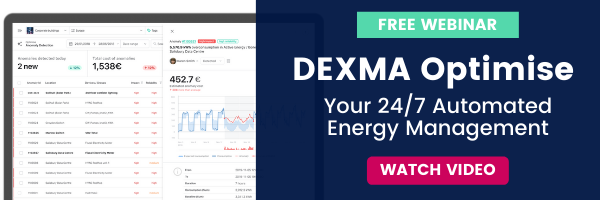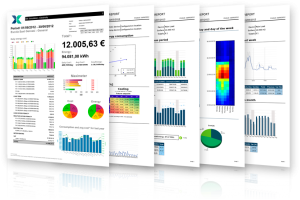If you work in the Energy Services Sector, you will already know how important it is to have useful tools in your day-to-day work. They help you improve both your productivity and to achieve the energy efficiency and savings objectives of your clients. That’s why in this article we bring you a list of 10 Energy Management Tools that are a must-have for you as an energy efficiency professional.
Companies must meet increasingly demanding energy efficiency and sustainability targets. And to achieve this, in many cases they must rely on the specialised services of experts in energy management such as the ones offered by your company.
For this reason, you should be very aware of the latest technologies and management solutions within the sector. They will be key to the development of your business, and the achievement of your clients’ objectives. In fact, the most innovative energy services companies tend to be the most successful and have the lowest customer churn rate.
What are the specialised tools for the energy services sector that you should be counting on in 2022?
1. Energy Savings Potential Detector
When you’re in the energy management business, it’s not uncommon to work with customers who need to manage energy from multiple locations.
As you know, the first step when starting a project with a new client is to conduct an energy audit of each of their buildings and facilities. This will help identify energy inefficiencies, visualise individual consumption, and set energy efficiency and savings targets.
But this first step can sometimes take a long time when it comes to multi-location projects: can you imagine, for example, how long it can take your team of energy managers to audit all the premises of a supermarket chain in a single region?
For these cases, the ideal is to have a tool that helps you to first detect the savings potential of each location. This will allow you to segment your client’s portfolio of buildings, organising the locations from highest to lowest savings potential, so that you can prioritise the places where it is most worthwhile to invest in energy efficiency. And all this, even before you physically go to see them.
This type of tool already exists, and it is called Dexma Detect. It is an energy management tool based on artificial intelligence and machine-learning technology. This solution will allow your energy service company (ESCO) to obtain a first virtual audit, with clear information and personalised recommendations on what actions make the most sense to start in your customers’ energy efficiency projects.
In addition, DEXMA Detect saves you money and time by suggesting customised energy saving actions you can take to reduce your energy bill, without the need for invasive hardware, software or auditing.
2. Consumption Viewer on Google Maps
Being able to visualise all the buildings you manage on a map is possible. In fact, this is one of the most used applications by energy managers on the DEXMA Platform.
Thanks to this tool, your team will be able to visualise the energy consumption of all the locations they manage by project and client on Google Maps.
The application in charge of this within the Dexma Platform is “Location Maps“. It is a tool with which you will be able to generate a ranking among all the locations, based on consumption ratios that you can customise such as date, energy sources, devices, active or reactive energy, among others.
In addition, you can apply different filters to visualise the locations by colour as efficient, normal or not very efficient.
And of course, you can see the consumption of any type of energy source: electricity, water, gas, diesel, production, heat and temperature.
3. Automatic Baseline Calculator
This tool is very useful for energy managers, as both during and at the end of the project they will need to monitor the savings being obtained.
In order to check whether savings are being achieved, energy experts need to have a benchmark to go by. This sounds simple, but calculating the “Baseline” or “Reference Consumption“, as you know, is not so easy. This number is based on the energy performance data of buildings over a period of 12 to 36 months, so calculating it manually can be complex and time-consuming.
In this case, Baseline calculators are the best solution. They automate the calculation of the “Reference Consumption” in an optimised way for your customers’ Verified Savings Measurement projects.
In the case of the Dexma Platform, you will find the ABC application (Automatic Baseline Calculator) with which you can obtain the best version of the Baseline, with the most explanatory variables and the best adjustment. In this explanatory video, you will better understand how it works:
4. Energy Saving Measurement & Verification Tool
This type of energy management tool is essential in any energy management and efficiency project. That’s why we include it as one of your must-haves for this year.
Not only will you and your team need to measure and verify whether all the defined points, established objectives and specific actions are being met. But your clients will also want to obtain reports to check whether their investment in energy efficiency is paying off.
For this task of managing your projects, your management team will need to create periodic “Measurement and Verification Reports” with which to monitor the savings and, if necessary, to detect possible deviations.
In this case, it is recommended to base your measurements and verification of savings on the IPMVP protocol. If you use a tool that is based on this international protocol, all the better.
Within the Dexma Platform you will find a tool called M&V with which you can not only calculate your Baseline automatically but also generate customised savings measurement and verification projects for each client and project.
M&V will allow you to define the sample period on which the Baseline will be based and the savings generated by the energy efficiency measures. I will as well define the type of savings project you want to measure (air conditioning, lighting, …) and the frequency at which the savings will be evaluated. In this video you will see in more detail how this tool works inside.
5. 24/7 Energy Consumption Anomaly Detector
When your clients’ energy efficiency projects are already well advanced, you need to keep reducing their bills, and you manage many projects at the same time, achieving savings for each one of them becomes complicated.
Energy management processes are still very manual, and the more detailed analysis of all the data takes a lot of time, which is in short supply when you are managing multiple customers and projects. In other words, energy management processes are still poorly automated.
According to a survey we conducted with +50 energy managers, most of them agreed that they can only perform an in-depth analysis of energy data once a month, once a quarter or even less frequently.
For these cases, the ideal is to have a tool that analyses energy data 24/7 for you and your team.
Dexma Optimise is an example of a 24/7 energy manager that automates energy analysis, detecting anomalies in the consumption of your customers’ installations. This will allow you to obtain new energy savings in your projects.
With this type of energy management tool, your team will get a list of anomalies detected automatically every day thanks, again, to Artificial Intelligence. In addition, they will be able to filter and prioritise the anomalies by energy and cost impact, responsible person and status.
If you want to know more about this tool, and see how it works inside, you can watch the Dexm Optimise Webinar here.
6. Carbon Footprint Calculator
When a client decides to carry out an energy efficiency project, they will not only have objectives to improve their consumption or reduce their costs. They may also have sustainability objectives such as reducing their carbon footprint.
Both legislative requirements and concerns about climate change have led companies to include more and more sustainability objectives in their annual plans.
In the case of an energy services company like yours, being able to offer the possibility of calculating the carbon footprint related to your client’s energy consumption can be a must.
That is why many ESCOs offer their services to obtain and improve the carbon footprint of their clients during their efficiency projects. So, you will need a Carbon Footprint calculator among the applications of your EMS.
An example of such a calculator is “Carbon Emission“, which will allow you to visualise the carbon footprint of all energy sources managed in each project. It will also let you know whether or not the locations you manage compliance with the regulations established for the emissions trading system.
7. Energy Consumption and Cost Forecasting Tool
Another essential tool for the management of your energy efficiency projects is the one that will allow you to predict energy consumption and its cost in the future. Especially now that the price of energy continues to rise.
At DEXMA we have the “Forecasting” application, a tool that allows you to obtain a forecast of the energy consumption and cost of your clients’ buildings one month in advance, as well as compare it with your different budgets and baselines.
The secret? Its artificial intelligence based on time series algorithms. So its accuracy in forecasting energy consumption will improve over time, particularly after 2 weeks, and even more so after 3 months. And you will only need at least 6 months of historical data.
8. Bespoke Energy Report Creator for each Customer
Of course, this type of tool cannot be missing from your daily essentials. This is a report creator that allows you to customise the information according to the client and the role of the person who is going to receive them (financial, maintenance manager, director, etc).
Sometimes the energy management solution with which your utility company works only allows you to create standard reports, with very generic data, which may not be sufficient for your client.
To solve this, the best option is to have an energy management tool that allows you to customise your client’s report with different graphs, colours, data periods, and time slots… and all in a couple of clicks. If you want to personalise it even more, you can even include your client’s branding, giving a little extra value to the report that they will love. If you already work with or have tried the DEXMA Platform, you will know how useful this option is.
9. Photovoltaic Energy Manager
As you may know, one of the objectives of the European Climate Change Plan is to make buildings NZEB. In other words, to convert them into “nearly zero-energy buildings”.
On the other hand, investment in Microgrids is also being encouraged: i.e. creating localised groups of electricity sources and supplies that are connected and synchronised with each other. These in turn operate in parallel with the traditional centralised grid but can disconnect and maintain their operation autonomously depending on the supply and demand of energy needed.
If a customer asked you to manage their Microgrid, do you have the tool to offer this service?
The DEXMA Platform has an application that allows you to monitor your customers’ Microgrids, analysing the Energy Balance between generation (e.g. PV plant), storage and energy consumption at your sites.
Even if you think that this tool is not for your energy services company, it is interesting to keep it in mind because, during the next few years, it will be more and more common to be requested.
10. Demand Load Application
This tool, although last on our list of must-haves for 2022, could very well be at the top of the list.
This is a calculator that obtains the maximeter of your customers’ devices, comparing it with their contracted power. So that if there is any excess, you will be alerted, avoiding possible penalties for your customers.
We remind you that the Maximeter is the average of the instantaneous power for a specific period. This period will vary depending on the sampling frequency used for each country.
In the case of England, for example, the sampling is every 30 minutes, so that the Maximeter represents the average power in 30 minutes.
Would you like to know more about these tools and try them yourself? Did you have any questions about how any of these tools can help you? Get in touch with our experts here, and solve your doubts without obligation.







